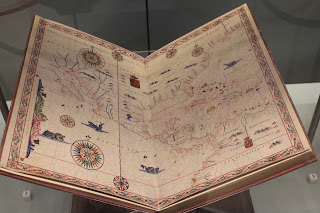We started off to visit the Palazzo Vecchio, but a portion of it was closed for a special event. We decided, instead to visit the Galileo Museum. We walked through the Piazza degli Uffizi again, and I took this shot to show you how the two parts of the building are connected.
Along the ground floor logia are niches with statues of famous Florentines.
Machiavelli
 Vespucci Galileo
Vespucci Galileo
 The Galileo Museum is in a small palazzo right behind the Uffizi.
The Galileo Museum is in a small palazzo right behind the Uffizi. In front is a unique sundial. The shadow projected by the glass polyhedron indicates true solar time and the period of the year, while the brass lines tell the hours, and the marble accents indicate months.

The museum came about, in part, because the Medicis had an interest in science. The collection was begun by Cosmo I and continued by subsequent generations. The family that succeeded the Medicis continued and expanded the collection.
Their map room was rather impressive. Hand made globes, early navigational almanacs and hand-drawn maps showed the Italian knowledge of the world.

This one had an interesting perspective... Italy is upside down from the way we usually see it, and while they got Libya and Egypt right, most of the rest of Africa and Asia are in the wrong places.
This nautical atlas from 1618 shows the Caribbean.
 |
| Galileo's experiments |
The majority of the museum is devoted to scientific equipment.
Galileo's studies of motion are featured, as are some of the advances he made in scientific equipment development (the thermoscope, for instance, the precursor of the thermometer).
 |
| electricity experiments |
 |
| 18th century Planetarium |
And clocks were everywhere.... big ones, little ones, perpetual motion ones, etc.
 |
| a 1510 planetary clock designed for the Medicis |









No comments:
Post a Comment